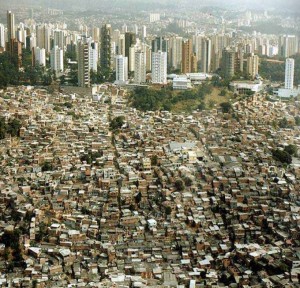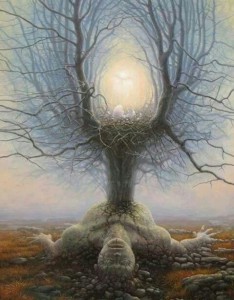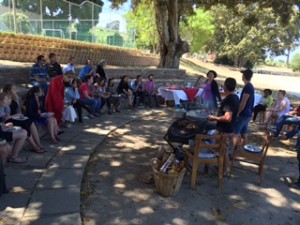Blog
Awakening the sleeping giant in all men
The post below was posted by Nick during a course on masculinity delivered by Charles Eisenstein: everyone should read this, especially men who – like me – feel like we live half lives within a patriarchal culture (or, to be more precise, a violent pornographic culture) that makes it almost impossible to be who we really want to be.
“There resides within men a sleeping giant… he is a dark and wild creature full of power and potential. I believe that accompanied by his feminine counterpart, together they can become an unstoppable force of love in action that can save the world.
His savage history is littered with atrocities that have wrought tremendous damage and brought unspeakable shame upon the masculine psyche. Right now he suffers from chronic repression and denial. But denying him is futile and can lead to perverted and unhealthy expressions of his magnificence.
He has always been here, he is here now, and he always will be.
He is uninhibited and boundless, unashamedly powerful, penetrating, passionate, loving and free. He is willing to face death for the sake of freedom, the outraged warrior who will march to certain oblivion in defence of truth and virtue … and he is waking up.
At the risk of offending some, I am going to be brutal and visceral here…
At times I feel a powerful and instinctive urge to either fuck or kill. This lizard brain emerges and I am ensconced in its skin. It is as much a feeling in the body as it is a thought in the mind.
I am ready to take any female that catches my eye and drag her into the cave. Testosterone is raging and there is an innate impulse to merge and explode into freedom from constraint, the “little death” that sets me free of the unbearable angst of being alive.
I am ready to kill. I can feel the primal animal underneath ready to snarl and fight it out to the death with anyone who poses a threat to my woman and children.
I am ready to hunt, prey and feed on any creature in my path that will nourish my tribe.
I do not act upon his every ravenous impulse. Instead, I endeavour to master and use this energy, to breathe him in, circulating his energy within my body, opening my heart and appreciating the source that inspired him to arise. Attempting to move the energy away from my head or my tail, to offer it back through the heart with love, honour and respect. When I successfully achieve this I am charged and enlivened with purpose and presence. But he is a wild stallion and it is easy to fall off, collapsing into anger or fantasy.
Any man with a masculine essence knows this beast. He is a dark and primal part of men, with deep roots in our evolution tracing back through the millennia. Indeed he may have served us well up until a few minutes ago in evolutionary time. He can even serve us well still if we can learn to harness his wild energy.
I often feel a deep shame around his energy. Through my own self judgement as much as the fear of how others will judge me. It has been deeply uncomfortable for me to share this with you.
There is a dense and heavy cultural baggage attached to this wild, potent masculine force and like me, I suspect every man feels the burden. So manifold are the horrors perpetrated by his dark energy that he is widely shunned and reviled as a force of evil and destruction. The war, the rape, the pillage and the patriarchal nightmare that is responsible for oppressing both women and men.
Men feel the pain and suffering of these violations deeply whilst at the same time having to recognise that we are capable of being the perpetrator. This weighs heavily on our collective conscious, even though as individuals, we may never have been directly responsible.
Yet I know that he is also a source of great power. When a man is able to stand comfortably in his dark masculine and bring his heart to it… this is truly a divine gift.
The rapist becomes the ravisher who loves his woman deeply with wild abandon.
The warmonger becomes the noble samurai who will put everything on the line, facing death to protect his family or to defend truth and freedom.
Let me tell you another secret… your woman will revel in his strength and virility! A man who can relax into his dark masculine energy whilst holding a deep heart connection with his lover can give and receive many exquisite gifts…
As much as he can love and adore her with integrity, and to his full capacity, she can trust him.
As much as he can feel into her deepest longing and desires, she can reveal them to him.
As much as he can probe deeply into her soft heart with sensitivity, penetrating through the layers, she may yield in pleasurable surrender.
As much as he can feel out from his heart into hers, responding to her subtle signals, whilst expressing fully his primal lustfulness, she can meet him with her wantonness or dare him further.
And if he worships her, kneeling before her in absolute devotion and service, she may merge with him fully, opening so completely that he no longer knows where he ends and she begins.
Don’t take my word for any of this, I wholeheartedly encourage men everywhere to embrace his power and discover these exquisite gifts!
The time is ripe for this wild masculine energy to emerge in men to protect our global tribe from the forces that threaten us. It is time to obliterate the patriarchal nightmare unfolding before us that threatens our freedom, our indigenous peoples, our eco systems and our very survival as a species.
This is a battle cry for the masculine to stand up and fight for justice, to defend the rights of the vulnerable, our children and future generations. The battle is within the hearts of men & woman everywhere and the battle ground is the heart of humanity.
Women are you ready to exalt this dark warrior of the heart?
Men are you ready to embody him?
The freedom drum is pounding and he is waking up, ready to dance with his divine goddess the wild feminine. It is a dance that burns with furious outrage and fierce compassion.
The power and energy that flows between them can destroy the illusion of power, greed, exploitation and separation with a love that knows no beginning and no end.”
For the original blog click here
Webinar with Marina Fischer-Kowalski on her recent report for the IRP on global trade and resource flows
Swaraj University – another education for sustainable futures intiative
Swaraj University in India – yet another example of an alternative education system that anticipates a future that most mainstream Universities cannot imagine. Educating for a sustainable future – that is what young people want today! Not the boring, discipline-based disconnected education they get offered that prepares them for nothing other than a certificate that proves they can pitch up on time for exams twice a year and occasionally to lectures.
Water crisis in Windhoek
I got an email today from a former student which said: “It is a few years since you mentioned that there will be a potential Windhoek water crisis… and now it arrived. Regards. Manjo” Gauteng, South Africa’s heartland, is very close to a similar crisis, but it is made worse by the steadily rising underground tide of Acid Mine Drainage (AMD) – a toxic cocktail left behind by the mines (70% of which no longer have owners) . The AMD then merges with the water that leaks about of the urban water system. Up to 40% of all potable water never reaches its destination – it leaks into the surrounding soils, and eventually filters down adding to the problem of rising levels of AMD. It is a matter of time before this starts to threaten drinking water supplies of this region where surface water has pollution has reached extremely high levels. When public notices go up in Gauteng about a water crisis, it will not merely be about shortages of water.
African urbanization, incrementalism and the role of transdisciplinary research
This video, entitled Africa’s Urban Future, is based on an extended interview with me about my understanding of the dynamics of African urbanization, what incrementalism means and the role that transdisciplinary research should play to support the process of incrementalism in African cities. The video is part of series of videos compiled by the Sustainability Institute for its Food Revolution programme. These reflections are based on five years of transdisciplinary research in Enkanini funded by the NRF, an informal settlement in Stellenbosch.
Green Industrialization and Cities in Africa
 The United Nations Economic Commission for Africa (UNECA) publishes a report each year that highlights a specific theme. Industrial Policy in Africa was the theme, for example, in 2014 was Industrial Policy for Africa. The theme for 2016 is Green Industrialization. This is significant because it flows from a resolution on greening African economies adopted at the African Union Conference of Ministers of Economy and Finance in March 2014 (an event that I attended). It also relates closely to the Green Economy Toolkit that we have developed for UNEP that will be applied in five African countries: Rwanda, Ghana, Kenya, Ethiopia and Mozambique. I have now been commissioned by UNECA to write a position paper on Green Industrialization and Cities in Africa that will be an input into the 2016 UNECA Report. I am excited about this because it will force me to integrate a lot of recent work and talks where I have attempted to connect ‘structural transformation’ and ‘urbanization’ in Africa, including the framing of the African urbanization component of the International Architecture Biennale Rotterdam 2016 that I am co-curating with Edgar Pieterse. Not easy because macro-economists ignore urbanization, and urbanists tend not to connect urbanisation to macro-economic processes and policies. The core message is clear: the ‘where’ of economic development (green or not) can no longer be ignored. Economic development always happens ‘somewhere’, and if those spaces are structurally and functionally dysfunctional, economic development will be severely constrained.
The United Nations Economic Commission for Africa (UNECA) publishes a report each year that highlights a specific theme. Industrial Policy in Africa was the theme, for example, in 2014 was Industrial Policy for Africa. The theme for 2016 is Green Industrialization. This is significant because it flows from a resolution on greening African economies adopted at the African Union Conference of Ministers of Economy and Finance in March 2014 (an event that I attended). It also relates closely to the Green Economy Toolkit that we have developed for UNEP that will be applied in five African countries: Rwanda, Ghana, Kenya, Ethiopia and Mozambique. I have now been commissioned by UNECA to write a position paper on Green Industrialization and Cities in Africa that will be an input into the 2016 UNECA Report. I am excited about this because it will force me to integrate a lot of recent work and talks where I have attempted to connect ‘structural transformation’ and ‘urbanization’ in Africa, including the framing of the African urbanization component of the International Architecture Biennale Rotterdam 2016 that I am co-curating with Edgar Pieterse. Not easy because macro-economists ignore urbanization, and urbanists tend not to connect urbanisation to macro-economic processes and policies. The core message is clear: the ‘where’ of economic development (green or not) can no longer be ignored. Economic development always happens ‘somewhere’, and if those spaces are structurally and functionally dysfunctional, economic development will be severely constrained.
Witnessing an actually existing transition to a green economy
I am spending the week in Addis with an amazing group of 40 Ethiopian officials and academics who are all directly involved in the implementation of Ethiopia’s Climate Resilient Green Economy (CRGE) policy and strategic programme. UNEP’s Regional Office for Africa was requested by the Ethiopian Government to assist the national effort by developing what has come to be called the Green Economy Toolkit (GETK). With funding from GIZ, SI Projects was contracted to coordinate a consortium of content and software development experts to develop the GETK. I am the formal head of this team (with Blake Robinson from SI Projects doing the day-to-day project coordination). The aim of the GETK is to provide sub-national governments in five African countries (Ethiopia, Rwanda, Ghana, Kenya and Mozambique) with a practical decision-support tool to develop sub-national green economy plans to capture project funds becoming available via a multiplicity of National Government budgets and international funds. Given the problem of capacity at sub-national government level across Africa, such a decision-support tool is of, course, an absolute necessity.
Starting end 2014, intensive research and several workshops have taken place to develop the content that has now been incorporated into a software programme developed by Forge (www.forgetech.net), a Cape Town-based software development company. The GETK is a step-by-step guide for formulating a green economy plan, with each step broken down into detailed actions linked to folders that contain descriptions of the most well-known approaches as well as planning tools and what they can be used for. This makes it possible for over-stretched officials to cut-and-paste text into their proposal templates, and to gain quick and easy access to the primary tools that they can rapidly deploy to conduct local analyses (e.g. soil analysis or waste characterisation) and facilitate local processes (e.g. how to set up and run a stakeholder workshop or manage resource conflicts). The GETK provides a step-by-step guide for formulating a general green economy plan for a specific sub-region, but also more detailed sectoral plans. Detailed descriptive information and related planning tools are included in the GETK for ten sectors: Agriculture, Food Systems and Nutrition, Energy Security and Low Carbon Energy Supply, Greener Resource Extraction & Industrial Activity, Integrated Waste Management and Waste Minimisation, Integrated Water Resource Management & Planning, Sustainable Built Environments & Urban Planning, Sustainable Fisheries, Sustainable Forest Management, Sustainable Mobility, Sustainable Tourism.
Significantly, the actual content information for each of the sectors has been developed by sector experts from the participating countries. This means that the tool kit architecture, software and research content have been entirely developed by Africans! I find this very inspiring.
The workshop here in Addis started with a presentation by Adugna Nemera, a very senior official from the Ministry of Finance and Economics. He gave a detailed history of the CRGE policy, and repeatedly emphasized how it has been thoroughly integrated into Ethiopia’s growth and development policy (after all, he is from the Ministry of Finance and Economics, and not the Ministry of Environment who were, by the way, the hosts of the workshop).The overall ambition is for this country of 80 million people to be a middle income country by 2025 without an increase in emission levels from 2010 levels (which then stood at 2 tons per capita). Such a commitment goes to the essence of what a sustainability-oriented development state looks like – the subject of my recent publication. An elaborate policy implementation structure has been established at national, regional and local levels, together with a budget and budget allocation mechanisms. The top decision-making structure is chaired by the Prime Minister’s Office, which is most impressive (and very different to what happens in South Africa where green economy is separate from economic growth strategies).
Facilitated by Dr. Desta Mebratu (based in Nairobi, but from Ethiopia), what impressed me most about this workshop was how these groups of officials and academics from the different regions plunged into applying the step-by-step guide to their respective sub-regions. Rehearsing the systemic logic of the planning approach inscribed in the GETK, using the support tools provided and adding in their own local knowledge, it was remarkable to see how such a tool helped to fast forward collaborative learning processes for the purposes of generating plans for capturing financial resources. What also really struck me was how the sector experts compiled their presentations in accordance with the ‘decision-support’ ethos of the GETK. In short, the GETK is a framework for formatting expert knowledge into user-friendly accessible information, and it also provides practitioners with a rapid learning platform for generating the kinds of plans that can generate new funding flows.
I think what impressed me most is the sophistication of the debates about the issues in the different sectors. Here is quite a young group of University educated Ethiopians using complex conceptual frameworks drawn from climate science, ecosystem science, resource economics and sustainability science to generate detailed analyses of developmental opportunities and constraints aimed at achieving in precisely quantified ways the goals of economic growth and improved wellbeing without increasing carbon emissions and simultaneously restoring natural systems (especially soils and forests). I have yet to come across anything remotely close to this in the South African context. And it is NOT the kind of reality that needs to be addressed in the global North.
After sitting and listening for a day and a half, I suddenly realized that I was witnessing in practice what an actually existing transition to a developmentally inclusive green economy must look like. One of the organisers, a young Ethiopian women who has studied sustainable agriculture, has agreed to take me to ride the new Addis metro this afternoon – what better tangible proof can there be of a long-term vision than a metro in a city where the majority live in informal settlements and where the middle class is set to expand rapidly (but now with an option to get around in a metro, not in cars). Of course this does not mean that all is just and good – land grabs, polluting Chinese industries, elite capture of public investments are all happening. But at least something is afoot here, and it seems a critical mass of well educated people employed by a state that is not afraid to be interventionist is definitely committed to making a sustainability-oriented transition happen.These are the people that I like working with. These are the kinds of processes that the Sustainability Institute is so well positioned to support over time.
Amazing new crop of Masters students
As I depart from Cape Town International on my way to Addis to co-facilitate a UNEP workshop on how to use the Green Economy Toolkit that has been developed for UNEP by SI Projects (back home next Thursday), I reflect back on an amazing week that started with presentations by the Masters students who have completed their research projects (pic is of me doing a braai for them) and ended with the students who are starting their Masters research projects due for completion end 2016. The whole idea is that in a transdisciplinary environment where it is very difficult to teach a particular research methodology, the best way for students who are commencing their research to learn about research methodology is to listen to students who have completed their research. When they listen to other students who have struggled and experimented all along the way, they soon realize there is no ‘right way’ to do research. They realize that research is an exploration that transforms them as they wrestle with the nexus between the real world they encounter and different ways of knowing. In the process their simplistic assumptions and normative commitments get questioned and challenged at the most fundamental levels, often triggered existential crises that can be profoundly transformative. As I always say to them: ‘Try to believe what you are skeptical about, and try to be skeptical about what you believe.’ This is easier said than done. The research topics of the ‘class of 2016’ are as follows:
- food insecurity amongst women in the informal economy
- how to promote the sale of healthy food in poor urban areas
- the commercial viability of a technical invention that converts plastic into diesel fuel
- Integrated Management Systems for corporates
- the role of ‘Big Data’ in qualitative (not quantitative) assessment of corporate sustainability performance
- African storytelling and the African environmental ethics
- globalisation, growth, urbanization and urban labour markets
- small-holder agro-ecological systems
- how the Sustainability Institute can be BBBEE partner for Independent Power Producers of Renewable Energy
- water politics in the Eersterivier Valley
- unraveling urban planning in Cape Town
- governance for accelerating sustainability transitions – a complexity perspective
- circular economy in Stellenbosch
This is an amazing group of students and I look forward to this time next year when they present their finished products – or the following year for those who will take two years (which is most of them). This is my favorite week of the year! What a ride, what a privilege to be part of it all.
Profile of the Class of 2016 – accepted into the Postgraduate Diploma in Sustainable Development
Nearly 130 people applied for entry into the Postgraduate Diploma in Sustainable Development. They were all more than qualified to be accepted, including a few very experienced people who did not have degrees. For the first time ever, nearly 40% of the applicants were non-South Africans. In the end I accepted 68. The profile is as follows: black women: 27; white men: 17; white women: 14; black men: 10. Total black participants: 37; total white participants: 31. Of the total 27 come from the private sector, 15 from government, 18 are full-time students, 7 from NGOs and 3 from the education sector. They come from South Africa, Malawi, Lesotho, Zimbabwe, Kenya, UK, Ghana, USA,
Italy and Brazil.





Recent Comments